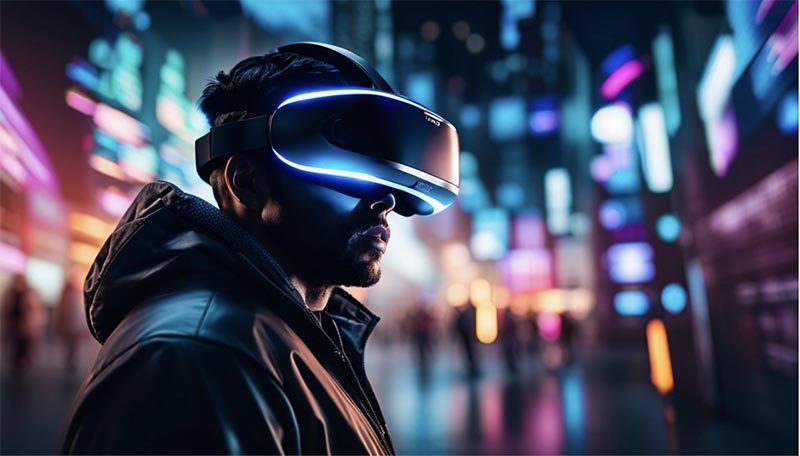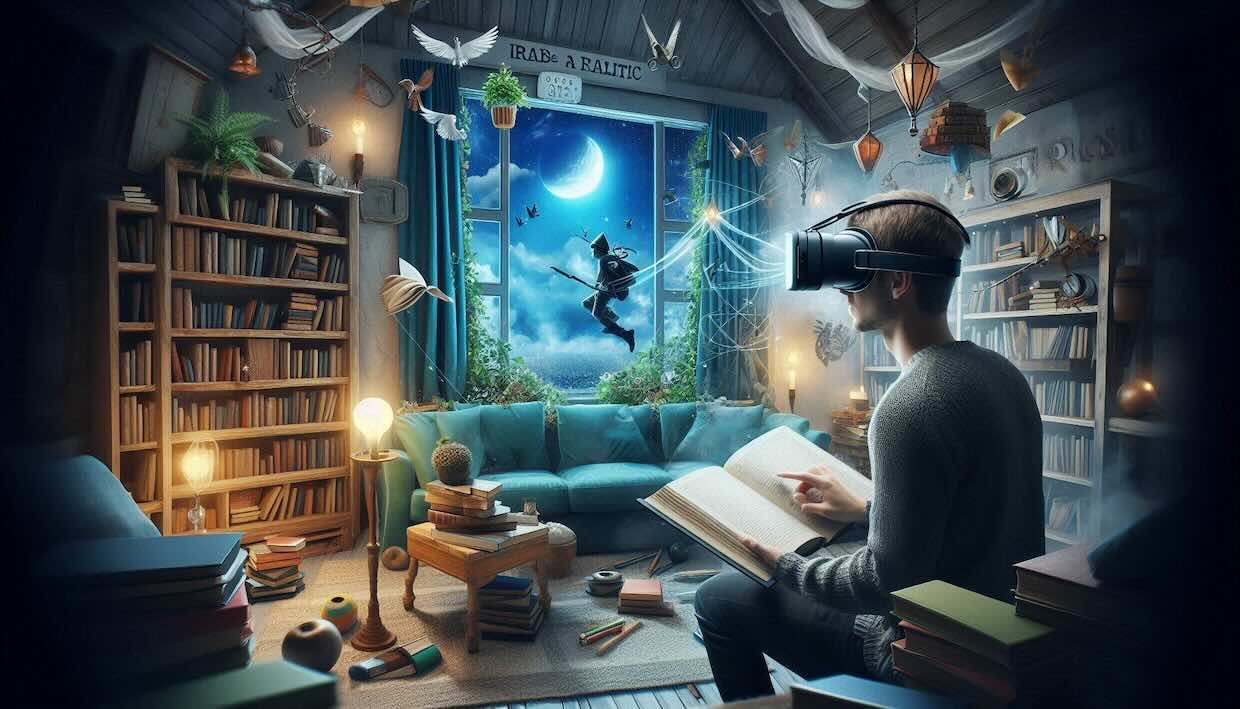Anime books, from light novels to manga and graphic novels, have long captivated readers with their compelling stories and intricate illustrations. As technology continues to evolve, so do the ways in which readers interact with these works. One of the most exciting developments in recent years is the integration of Virtual Reality (VR) into the anime book reading experience. By merging anime books with cutting-edge VR technology, the traditional reading experience is being transformed into a more immersive, interactive, and engaging journey.
In 2024, VR is providing anime fans with the ability to dive deeper into their favorite stories, becoming a part of the world they’ve only previously imagined. In this post, we will explore how VR is enhancing the anime book experience, from interactive storytelling to fully immersive environments that allow fans to engage with their favorite characters and plots in entirely new ways.
1. Immersive Storytelling: Stepping Into Anime Worlds
Traditionally, anime books have relied on words and illustrations to transport readers to new worlds. However, virtual reality takes that immersion to the next level. With VR headsets, readers can now “step into” the worlds depicted in their favorite anime books. Through VR, the environment, characters, and even the emotions conveyed in the story can be experienced in three dimensions.
Imagine reading a light novel or manga about a fantastical kingdom or futuristic city, and then being able to don a VR headset and physically walk through the streets of that city or interact with the characters. The walls and landscapes from the pages of the book come to life, creating an experience where the boundaries between the reader and the story begin to blur.
Example: VR-enhanced manga experiences could allow readers to wander through a detailed virtual version of the manga’s setting, meeting characters along the way and engaging in mini-games or dialogue that further enrich the story.
2. Interactive Elements: Beyond Passive Reading
One of the key features of VR technology is its ability to allow users to interact with their environment. This element of interactivity is beginning to be integrated into anime books, making reading more engaging and participatory.
In VR versions of anime books, readers might be able to interact with the story’s characters or objects within the environment, influencing the plot and making decisions that impact the direction of the narrative. This shift turns anime books from passive experiences into interactive ones, where readers aren’t just observing the action—they’re an active part of the story.
Example: In a VR-enhanced anime book, readers might be given a choice in a crucial moment—such as whether the protagonist chooses to save a character or let them go—and see the consequences of that decision unfold in real-time. This creates a deeper level of engagement and investment in the story.
3. Expanding the Storytelling Medium: Audio and Visual Integration
Anime books, particularly manga, rely heavily on illustrations and visual storytelling. However, VR technology takes these visuals a step further by integrating sound, music, and voice acting into the experience. This multi-sensory integration amplifies the emotional impact of the story and helps readers connect with the characters and plot on a deeper level.

For example, VR adaptations of anime books might feature fully-voiced characters, allowing readers to hear their favorite protagonists and side characters speak in their native languages or even with voice actors from the anime series. The music and sound effects also heighten the immersive atmosphere, making it feel as if you’re right there in the world of the anime.
Example: A VR experience of a popular anime book could feature atmospheric soundtracks, dialogue, and ambient noise that make the setting feel real—whether it’s the rustling of leaves in a forest or the clinking of swords in a battle.
4. Enhanced Character Interaction: Bringing Characters to Life
A big part of what makes anime books special is the emotional connection readers develop with the characters. With VR, this connection becomes even more tangible. Through VR technology, characters from anime books can be brought to life in a 3D space, allowing readers to interact with them in real-time.
In some VR experiences, the characters might be fully animated and able to respond to reader input, whether through spoken words or actions. This could allow readers to have personalized, interactive conversations with the characters, fostering a deeper emotional connection with them.
Example: In a VR anime book experience, readers might be able to sit down with their favorite character and engage in a meaningful conversation, where the character’s responses evolve based on previous interactions, providing a dynamic and evolving experience.
5. Multi-Sensory Environments: Engaging More Than Just Sight and Sound
One of the most exciting advancements in VR for anime books is the potential to engage more than just sight and sound. Advanced VR systems are beginning to incorporate haptic feedback—a technology that allows users to physically feel certain sensations within the virtual environment. This could take the immersive experience of anime books to new heights.
Imagine reaching out to touch a magical artifact or feeling the rush of wind as a character runs past you. Haptic feedback could allow readers to “feel” the environments of their favorite anime worlds, from the warmth of a summer day to the cold, eerie atmosphere of a haunted house. By engaging multiple senses, VR enhances the emotional impact of the story.
Example: A VR anime book that lets readers feel the texture of an ancient sword in their hands or experience the pulse of a battle as the ground shakes beneath their feet.
6. Virtual Reality Manga: A New Form of Digital Manga
While traditional manga relies on static images on a page, VR manga offers a revolutionary way to experience the art form. Instead of flipping through pages, readers could immerse themselves in the manga’s world, watching the art come to life in 3D. The characters, once confined to two-dimensional panels, now move, express emotions, and interact with the world around them in ways that are impossible on paper.
This form of VR-enhanced manga could also allow readers to explore different angles of the artwork, giving them a deeper understanding of the illustrations and allowing them to experience the manga in a more interactive and engaging way.
Example: VR manga readers could enter a scene where they can examine the artwork from every angle, immersing themselves in the visual design and enjoying detailed animations and visual effects.
7. Pushing Boundaries: The Future of VR in Anime Books
As the VR industry continues to evolve, so will the possibilities for anime books. New technologies, such as eye-tracking, gesture recognition, and AI-driven storylines, will likely enhance the level of immersion and interaction within VR anime book experiences. In the future, VR could allow readers to create their own unique stories or explore different versions of the same book.
Moreover, with VR becoming more accessible, it’s possible that in the coming years, the anime book industry will see an explosion of VR-based adaptations, revolutionizing the way fans experience their favorite stories.
Example: A VR anime book experience that allows readers to design their own character or explore alternate realities, where different choices lead to entirely different endings.
Conclusion: The Future of Anime Books in Virtual Reality
Virtual Reality is poised to redefine the anime book reading experience by making it more interactive, immersive, and dynamic. Whether through enhanced storytelling, character interaction, or multi-sensory environments, VR technology is creating exciting new possibilities for fans of anime literature. As VR technology continues to evolve, we can expect even more innovative ways to engage with anime books, providing an experience that is both visually stunning and emotionally immersive.
In the years to come, VR could become an integral part of how we read and interact with anime books, offering readers a level of immersion and connection with stories that was once thought impossible. The future of anime books is undoubtedly bright, with virtual reality leading the way toward a more engaging, personalized, and exciting world of storytelling.











